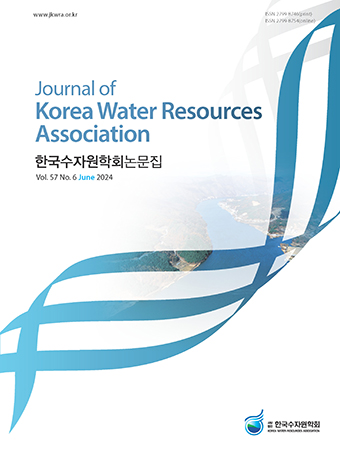Research Article
Anderson, E.A. (1976). A point energy and mass balance model of snow cover. NOAA Technical Report NWS 19, U.S. Dept. of Commerce, National Weather Service, MD, U.S., pp. 42-137.
Blaney, H.F., and Criddle, W.D. (1950). "Determining water requirements in irrigated area from climatological irrigation data." US Department of Agriculture, Soil Conservation Service, Technical Paper, 96, p. 48.
Cho, H.K., and Kim, S.M. (2019). "Estimation of the Hapcheon Dam inflow using HSPF model." Journal of the Korean Society of Agricultural Engineers, Vol. 61, No. 5, pp. 69-77.
Choi, C.K., Kim, T., and Choi, Y.S. (2022). "A study on prediction method for flood risk using LENS and flood risk matrix." Journal of Korea Water Resources Association, Vol. 55, No. 9, pp. 657-668.
10.3741/JKWRA.2022.55.9.657Choi, Y.S., and Kim, K.T. (2024). Grid based rainfall-runoff model User's manual. Korea Institute of Civil Engineering and Building Technology. pp. 1-42.
Choi, Y.S., Choi, C.K., Kim, H.S., Kim, K.T., and Kim, S.J. (2015). "Multi-site calibration using a grid-based event rainfall-runoff model: a case study of the upstream areas of the Nakdong River basin in Korea." Hydrological Processes, Vol. 29, pp. 2089-2099.
10.1002/hyp.10355Choi, Y.S., Kim, K.T., and Lee, J.H. (2008). "Development of grid based distributed rainfall-runoff model with finite volume method." Journal of Korea Water Resources Association, Vol. 41, No. 9, pp. 895-905.
10.3741/JKWRA.2008.41.9.895Ellenburg, W.L., Cruise, J.F., and Singh, V.P. (2018). "The role of evapotranspiration in streamflow modeling - An analysis using entropy." Journal of Hydrology, Vol. 567, pp. 290-304.
10.1016/j.jhydrol.2018.09.048Feng, M., Zhang, W., Zhang, S., Sun, Z., Li, Y., Huang, Y., Wang, W., Qi, P., Zou, Y., and Jiang, M. (2022). "The role of snowmelt discharge to runoff of an alpine watershed: Evidence from water stable isotopes." Journal of Hydrology, Vol. 604, 127209.
10.1016/j.jhydrol.2021.127209Gupta, H.V., Kling, H., Yilmaz, K.K., and Martinez, G.F. (2009). "Decomposition of the mean squared error and NSE performance criteria: Implications for improving hydrological modelling." Journal of Hydrology, Vol. 377, pp.80-91.
10.1016/j.jhydrol.2009.08.003Hamon, W.R. (1961). "Estimating potential evapotranspiration." Journal of Hydraulics, ASCE. Vol. 87, pp. 107-120.
10.1061/JYCEAJ.0000599Hargreaves, G.H., and Samani, Z.A. (1985). "Reference crop evapotranspiration from temperature." Applied Engineering in Agriculture, Vol. 1, No. 2, pp. 96-99.
10.13031/2013.26773Jung, C.M., Shin, M.J., and Kim, Y.O. (2015). "a comparison study of runoff projections for Yongdam Dam watershed using SWAT." Journal of Korea Water Resources Association, Vol. 48, No. 6, pp. 439-449.
10.3741/JKWRA.2015.48.6.439Jung, I.W., and Bae, D.H. (2005). "A study on PRMS applicability for Korean river basin." Journal of Korea Water Resources Association, Vol. 38, No. 9, pp. 713-725.
10.3741/JKWRA.2005.38.9.713Jung, I.W., Lee, B.J., Jun, T.H., and Bae, D.H. (2008). "Hydrological model response to climate change impact assessments on water resources." Journal of Korea Water Resources Association, Vol. 41, No. 9, pp. 907-917.
10.3741/JKWRA.2008.41.9.907Kang, S.U., Lee, D.R., and Lee, S.H. (2004). "A study on calibration of tank model with soil moisture structure." Journal of Korea Water Resources Association, Vol. 37, No. 2, pp. 133-144.
10.3741/JKWRA.2004.37.2.133Kim, B.S. (2005). Impact assessment of climate chanage on hydrologic components and water resources in watershed. Ph.D. Dissertation, Inha University, pp. 199-202.
Kim, C.G., and Kim, N.W. (2012). "Comparison of natural flow estimates for the Han River Basin using TANK and SWAT models." Journal of Korea Water Resources Association, Vol. 45, No. 3, pp. 301-316.
10.3741/JKWRA.2012.45.3.301Kim, D.H., and Kim, S.M. (2017). "Estimation of inflow into Namgang Dam according to climate change using SWAT model." Journal of the Korean Society of Agricultural Engineers, Vol. 59, No. 6, pp. 9-18.
KIm, K.T., Choi, Y.S., and Lee, H.J. (2010). "Comparison and examination of the calculating hydrological geographic parameters using GIS." Journal of Korea Water Resources Association, Vol. 43, No. 1, pp. 25-39.
10.3741/JKWRA.2010.43.1.25Kim, K.U., Song, J.H., Ahn, J.H.., Park, J.H., Jun, S.M., Song, I.H., and Kang, M.S. (2014). "Evaluation of the tank Model optimized parameter for watershed modeling." Journal of the Korean Society of Agricultural Engineers, Vol. 56, No. 4, pp. 9-19.
10.5389/KSAE.2014.56.4.009Kim, N.W., Shin, A.H., and Kim, C.G. (2009). "Comparison of SWAT-K and HSPF for hydrological components modeling in the Chungju Dam watershed." Journal of the Envrionmental Sciences, Vol. 18, No. 6, pp. 609-619.
10.5322/JES.2009.18.6.609Kim, S.R., and Kim, S.M. (2018). "Evaluation of HSPF model applicability for runoff estimation of 3 sub-waterhsed in Namgang Dam watershed." Journal of Korean Society on Water Envrionment, Vol. 34, No. 3, pp. 328-338.
Kim, S.Y., and Yoon, K.S. (2019). "A study on the determination of the optimal resolution for the application of the distributed rainfall-runoff model to the flood forecasting system - focused on Geumho river basin using GRM." Journal of Korea Water Resources Association, Vol. 52, No.2, pp. 107-113.
10.3741/JKWRA.2019.52.2.107Korea Institute of Civil Engineering and Building Technology (KICT). (2004). Public applications research of satellite data: A study of river information production and application using satellite images. pp. 69-75.
Korea Institute of Civil Engineering and Building Technology (KICT). (2005). Public applications research of satellite data: A study of river information production and application using satellite images. pp. 125-130.
Lee, E.H., and Seo, D.I. (2011). "Flow calibration and validation of Daechung Lake watershed, Korea using SWAT-CUP." Journal of Korea Water Resources Association, Vol. 44, No. 9, pp. 7111-720.
10.3741/JKWRA.2011.44.9.711Lee, M.H., Im, E.S., and Bae, D.H. (2019). "Future projection in inflow of major multi-purpose dams in South Korea." Journal of Wetlands Research, Vol. 21, No. s-1, pp. 107-116.
Lee, M.J., Yoo, Y.H., Joo, H.J., Kim, K.T., Kim, H.S., and Kim, S.J. (2021). "Construction of rating curve at high water level considering rainfall effect in a tidal river." Journal of Hydrology: Regional Studies, Vol. 37, 100907.
10.1016/j.ejrh.2021.100907Lee, S.H., Ahn, T.J., Yun, B.M., and Shim, M.P. (2003). "A tank model application to Soyanggang Dam and Chungju Dam with Snow accumulation and snow melt." Journal of Korea Water Resources Association, Vol. 36, No. 5, pp. 851-861.
10.3741/JKWRA.2003.36.5.851Lee, S.H., and Kang, S.U. (2007). "A parameter regionalization study of a modified tank model using characteristic factors of watersheds." Journal of the Korean Societyof Civil Engineers, Vol. 27, No. 4B, pp. 379-385.
Lee, S.H., Seong, Y.J., and Jung, Y.H. (2022). "LENS-GRM applicability analysis and evaluation." Water, Vol. 14, 3897.
10.3390/w14233897National Institute of Agricultural Science and Technology (NAS). (1992). Supplement: An introduction to Korean soils. Soil Survey Material 13, The Rural Development Administration, pp. 283-290.
Neitsch, S.L., Arnold, J.G., Kiniry, J.R., and Williams, J.R. (2005). Soil and water assessment tool theoretical documentation. Agricultural Research Service, TX, U.S., pp. 57-121.
Ponce, V.M. (1989). Engineering hydrology: Principles and practices. Prentice Hall, Englewood Cliffs, NJ, U.S., pp. 43-52.
Priestley, C.H.B., and Taylor, R.J. (1972). On the assessment of surface heat flux and evaporation using large-scale parameters. Monthly Weather Review 100, Division of Atmospheric Physics, Victoria, Australia, pp. 81-92.
10.1175/1520-0493(1972)100<0081:OTAOSH>2.3.CO;2Shim, S.K., Koo, B.Y., and Ahn, T.J. (2009). "Development of combination runoff model applied by genetic algorithm." Journal of Korea Water Resources Association, Vol. 42, No. 3, pp. 201-212.
10.3741/JKWRA.2009.42.3.201Shin, M.J., and Choi, Y.S. (2018). "Sensitivity analysis to investigate the reliability of the grid-based rainfall-runoff model." Water, Vol. 10, 1839.
10.3390/w10121839Sung, Y.K., Kim, S.H., Kim, H.J., and Kim, N.W. (2004). "The applicability study of SIMHYD and TANK model using different type of objective functions and optimization methods." Journal of Korea Water Resources Association, Vol. 37, No. 2, pp. 121-131.
10.3741/JKWRA.2004.37.2.121Woo, S.Y., Lee, J.W., Kim, Y.W., and Kim, S.J. (2020). "Assessment of future stream flow and water quality of Man-gyeong River watershed based on extreme climate change scenario and inter-basin water transfer change using SWAT." Journal of Korea Water Resources Association, Vol. 53, No. 8, pp. 605-616.
- Publisher :KOREA WATER RESOURECES ASSOCIATION
- Publisher(Ko) :한국수자원학회
- Journal Title :Journal of Korea Water Resources Association
- Journal Title(Ko) :한국수자원학회 논문집
- Volume : 57
- No :4
- Pages :289-300
- Received Date : 2024-03-27
- Revised Date : 2024-04-12
- Accepted Date : 2024-04-12
- DOI :https://doi.org/10.3741/JKWRA.2024.57.4.289



 Journal of Korea Water Resources Association
Journal of Korea Water Resources Association









